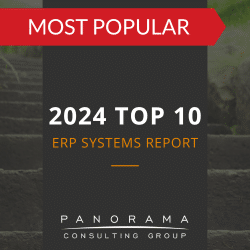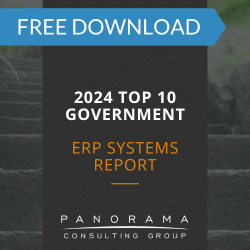Between December 19 and December 28, 2022, Southwest Airlines was forced to cancel more than 16,000 flights, leaving thousands of people stranded for days. How did such a massive failure occur, especially during peak travel season?
In the beginning, it seemed as though adverse weather was the primary culprit. After all, there was a massive winter storm over the holiday weekend. There were record-breaking temperature drops and harsh, snowy conditions across much of the central and eastern U.S.
However, it quickly became evident that the company’s outdated IT systems were primarily to blame.
Today, we’re breaking down exactly how the Southwest Airlines ERP failure occurred. We’ll also share how companies can prevent similar breakdowns.
The Southwest Airlines ERP Failure: What Happened?
In time, other airlines began to recover from storm-related delays. However, Southwest Airlines continued to cancel flights and keep planes on the ground. Before long, company representatives, including the airline’s CEO, were required to explain the setback.
The main issue was the IT and infrastructure that Southwest was using to recover from the disruptions. While these tools worked “99% of the time” they were not foolproof. They were also older and in need of major system upgrades, with many systems implemented in the 1990s.
Though the company had plans in place to upgrade the tools, they were not carried out in time to prevent the December disaster. As a result, when the weather-related delays occurred, the systems couldn’t handle new and unexpected demands.
This included an uptick in flight schedules, as well as new assignments for crews. Without the right ERP software in place, it became nearly impossible for staff members to assign team members and flights where they needed to be.
A Failed Payroll System Implementation
Panorama’s Expert Witness team was retained to provide a forensic analysis and written report to the court regarding the failed implementation of a major software developer’s ERP/payroll system.
Key Takeaways and Lessons Learned
Even if you aren’t at the helm of a major airline, you can still learn some valuable insights from the Southwest Airlines ERP failure. Let’s look at some of the key lessons learned.
1. Digital Transformation Is Here to Stay
If we learn nothing else from this ERP failure, it’s this: Digital transformation is here to stay, and it’s time to invest in it.
Expecting outdated legacy systems to keep your company competitive, responsive, and relevant is a risky move, no matter what industry you’re in.
Though Southwest Airlines is worth more than $20 billion, records show that its technology investment is comparatively minuscule. While it recently announced plans to increase this investment, its original digital transformation effort, initiated in 2017, was under-par. As a whole, the technological overhaul was valued at around $800 million, but only $300 million of that was reserved for new technology.
Underinvesting in the right tools frustrates customers and also affects your team members, stakeholders, and ultimately, your bottom line. Don’t wait until your legacy systems begin to pose an operational risk and put you into major technical debt.
An ERP consulting firm like Panorama can ensure you’re not only investing in digital transformation but that you’re investing enough.
2. Equip Your Team Members Appropriately
One of Southwest’s issues was an inability to contact employees in a timely manner as plans changed. For instance, there wasn’t an automated way to inform them when their shifts were reassigned.
There should always be a secure, dependable system in place to reach employees during a time of crisis. The protocols should be outlined by your HR department and supported by multiple technologies. This way, you can contact everyone, ensure their safety, and help them navigate next steps.
If your business operates a call center, make sure it’s equipped in the same way. Representatives should be well-versed in handling a massive influx of calls, with the right technology at their fingertips to support their work.
3. Create Plans to Pivot
When a crisis strikes, how quickly would you be able to realign your operations? Do all of your managers and department leaders have access to the tools they need to make decisions quickly and accurately?
No? Then, you may want to consider technology such as:
• Collaboration tools
• Forecasting machine learning models
• Advanced data analytics
• Real-time reporting dashboards
An ERP system is a great place to start. These platforms come equipped with integrated analytics tools that make it easier to identify, respond, and react to an unanticipated event.
Though Southwest had scheduling software in place to re-route operations, it failed to do so. As a result, the company had to rely on manual operations, which required more intervention and increased the risk of human error.
Invest in Modern Digital Tech to Stay Responsive and Avoid IT Failures
The Southwest Airlines ERP failure reveals what can happen when a company fails to invest in modern digital technology.
For Southwest, the losses now include decreased customer loyalty and poorer brand reputation, in addition to what they must spend to bring their systems up to speed.
Ready to jumpstart your own digital transformation? If so, contact one of our ERP implementation consultants below for a free consultation.














